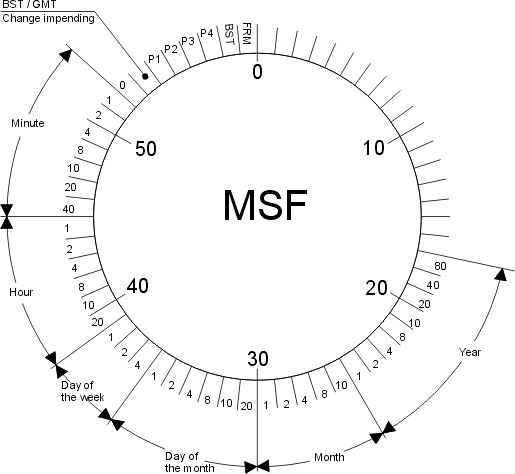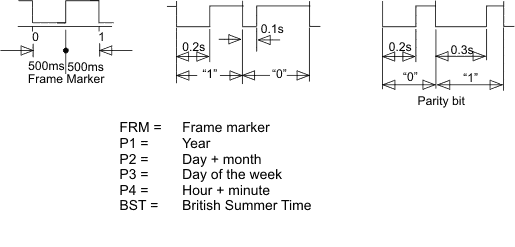|
|
|
 |
|
 |
| |
| Station: |
| MSF |
| Frequency: |
| 60 kHz |
| Transmitting
power: |
| 15 kW |
| Location: |
| |
| Receiving
area: |
| 1200 km |
| Geographical
coordinates: |
| 54° 55' N, 03° 15' W |
| Time
of transmission: |
| |
| Modulation: |
| 100% |
|
|
 |
|
 |
|



Time code information according the UK's national
standards laboratory of physical measurements document
The information is present as a continuous bit stream with a data rate
of 1 bit per second by using pulse with modulation.
The power of the carrier is switched off at the beginning of a second
for a certain time. The second 0 (minute marker) is represented by 0.5
seconds "off". The other information is represented by a 0.1
second "off" (binary 0) or at least 0.2 second "off"
(binary 1). The leading edge of every negative going pulse is on time.
The also available "fast code" (DUT Code) cannot be obtained
by a time code receiver IC described in this publications and will be
ignored so far.
The binary coded decimal (BCD-code) format is used to combine binary digits
in order to represent decimal numbers. (for location of the information,
as well as content, see drawing).
The minute identifier is combined by an unique bit combination of 01111110.
Therefore, bit 53, 54, 55, 56, 57 and 58 are all permanently "1"
(0.2 second "off" time) and are always preceded by Bit 52 at
"0" and followed by Bit 59 at "0". This combination
does never appear elsewhere in a bit combination.
The Parity bits have a different signal length.
The Bit 54, 55, 56 and 57 have an additional function as parity bit. This
is achieved by an "off" time of 0.3 seconds.
Example:
Bit 54 is always 0.2 or 0.3 seconds "off". This bit is in the
normal context counted as a binary "1" (0.2 sec. "off"
or more). If the length of the "off" time is measured, we get
an additional information, if the "off" time is 0.2 or 0.3 sec.
If the "off" time is 0.3 seconds, this represents for the parity
bit a "1" if it's 0.2 seconds, it's a "0"
With this information, the parity bit 54 together with the bit 17 to 24
(Year) provides an odd number of "1".
Parity Bit 55 together with 25 to 35 (month and day of the month) provides
an odd number of "1".
Parity Bit 56 together with Bit 36 to 38 (day of the week) provides an
odd number of "1". Parity Bit 57 together with Bit 39 to 51
(hour and minute) provides an odd number of "1".
So far, all necessary information of time, day of the year and year, day
of the week (and some additional information) can be decoded out of the
signal.
Please verify this information before commercial use !
http://www.npl.co.uk/time/msf/ctm001v05.pdf
Please be informed that for quarterly maintenance reasons the transmitter
is periodically switched off. The Information of down time can be taken
from http://www.npl.co.uk/time/msf/msfoutages.html

|







